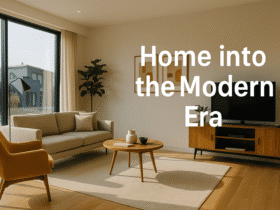Key Takeaways:
Interior design is a cornerstone in crafting aesthetically pleasing and highly functional spaces. Design plays a critical role in enhancing mood, productivity, and overall satisfaction in residential and commercial settings through the strategic use of space, color, and light. It’s an investment in beauty, improved quality of life, and business efficiency.
Table of Contents:
- Introduction
- Influence of Interior Design on Residential Spaces
- Impact on Commercial Environments
- Key Elements of Interior Design
- Innovative Approaches to Design
- Designing Sustainable and Efficient Spaces
- Conclusion
Introduction
Interior design transcends mere decoration or furniture arrangement, profoundly molding residential and commercial environments’ functionality, atmosphere, and personality. As human requirements’ complexity evolves, so does the importance of thoughtful design strategies. Whether crafting a serene home sanctuary or engineering a vibrant workspace conducive to creativity and productivity, interior design is central to creating spaces that fully support and enhance their inhabitants’ lifestyles and work habits. It integrates color, lighting, texture, and spatial planning to evoke specific emotions and experiences. A well-designed space can improve mental well-being, boost productivity, and influence behavior. Sustainable and ergonomic design choices are becoming increasingly vital as people seek aesthetically pleasing and environmentally responsible environments. Interior design also plays a key role in expressing individual or brand identity, turning ordinary spaces into unique reflections of personality or company values. As trends and technologies continue to evolve, so does the potential for interior design to transform how we live and work.
Influence of Interior Design on Residential Spaces
Interior design is indispensable in transforming residential properties into visually and functionally delightful homes. An optimized layout with carefully chosen aesthetics can significantly influence the happiness and comfort of its residents. Effective design considers how individuals use spaces, combining practicality with style to create livable and stylish environments.
Professional interior designers, such as those from Denver’s premier interior design specialists at Divine Home Today, excel in creating living spaces that meet aesthetic desires and optimize for factors such as space utilization and natural lighting, contributing to an enhanced quality of life. By carefully considering the spatial relationships and flow between different areas, skilled designers ensure that homes cater perfectly to their occupants’ lifestyles and daily routines. Thoughtful interior design can promote mental well-being by reducing visual clutter and enhancing organization. Calming color schemes, tactile textures, and strategic lighting can create a more soothing and restorative environment. Personalized touches, from artwork to custom furnishings, make residents feel more emotionally connected to their living space. In addition, sustainable and eco-conscious design choices can align the home with modern values of environmental responsibility. Ultimately, great interior design beautifies a home and supports a more balanced, intentional way of living.
Impact on Commercial Environments
Interior design becomes a tool for aligning space with strategic business goals in commercial settings. Thoughtfully curated environments can improve employee efficiency and positively impact customer experiences. For instance, the design of an office space greatly influences productivity; open floor plans may promote collaboration, while private, quiet areas may enhance focus-driven tasks.
Similarly, design shapes client perceptions and behaviors in customer-facing venues such as shops or restaurants. A retail store with an inviting layout will likely see increased foot traffic and longer browsing, leading to potential sales growth. By prioritizing user experience, commercial spaces become more than just functional—they become key assets in achieving business success. Color schemes, lighting, and materials influence mood and decision-making, subtly guiding behavior through design psychology. A well-designed lobby or reception area can set the tone for the entire client relationship from entry.
Additionally, flexible layouts that adapt to evolving needs allow businesses to remain agile in a competitive market. Incorporating biophilic elements like greenery and natural light has been shown to reduce stress and enhance well-being in the workplace. Ultimately, intentional design choices serve aesthetic purposes and contribute directly to brand identity and operational effectiveness.
Key Elements of Interior Design
Understanding and employing the principal components of interior design is crucial to creating harmonious spaces. These components—space, line, form, light, color, texture, and pattern—collectively build the foundation for successful design:
Space: The fundamental element in design is the areas within structures that are available for setup and utilization. Thoroughly analyzing the space ensures that each area serves its intended purpose efficiently.
Lines: Lines impart direction and structure, creating visual paths that guide the eye through a space. Whether horizontal, vertical, or dynamic, lines help establish a room’s visual architecture.
Forms: The room’s shape and objects constitute forms that contribute to the setting’s character and feel. Using either geometric or organic forms can define a room’s aesthetic.
Light: Whether natural or artificial, light shapes how a space is perceived. Thoughtful lighting design can profoundly influence ambiance, affecting everything from color perception to mood.
Color: Colors wield the power to evoke emotional responses and impact how a room is used and enjoyed. Creating a cohesive color palette is essential for developing a pleasing visual experience.
Texture and Pattern: Adding texture and pattern injects depth and interest into a room, preventing it from feeling flat. These elements, created through fabrics or finishes, contribute to a space’s tactile and visual richness.
When balanced correctly, these elements can elevate the simplest interiors into engaging and functional environments. Designers often use these tools to express specific themes or styles, reinforcing the space’s personality. It’s important to consider how each element interacts with the others to maintain visual harmony. Personal preferences and practical needs should also guide design choices to ensure comfort and usability. Ultimately, mastering these key elements empowers designers and homeowners alike to transform ordinary rooms into inspiring, livable works of art.
Innovative Approaches to Design
Modern interior design is marked by constant innovation, driven by advancing technology and evolving consumer expectations. An increasing number of designers are leveraging tools like virtual reality to allow clients to fully envision spaces before construction begins, reducing the chances of costly mistakes.
Furthermore, modular design, which offers flexible solutions that adapt to diverse needs, is gaining traction. This approach ensures versatile use of space, particularly in environments where adaptability is essential, such as multigenerational homes or dynamic office settings. With innovative technology, modern designs are becoming increasingly personalized and responsive, significantly enhancing convenience and comfort. Sustainable materials and energy-efficient systems also play a larger role, reflecting a growing demand for eco-conscious design. Biophilic elements—like natural lighting, plant integration, and organic textures—are embraced to promote wellness and connect occupants to nature. Data-driven design enables more informed choices, using analytics to understand how people interact with spaces and optimize functionality. Designers are also exploring mixed-use layouts that seamlessly combine living, working, and leisure areas within a single environment. This fusion of creativity, technology, and sustainability is setting new standards for the future of interior design.
Designing Sustainable and Efficient Spaces
As modern society emphasizes environmental consciousness, sustainable interior design has gained precedence. This approach aims to minimize adverse environmental impacts and create healthier spaces for inhabitants. Designers are integrating sustainable materials, such as recycled wood and bamboo, that offer durability without contributing to environmental degradation.
Additionally, efficiency-driven design prioritizes energy efficiency and resource conservation. By incorporating components like solar panels or energy-efficient lighting systems, spaces become less burdensome to maintain and more respectful of natural reserves. This commitment to sustainability extends to optimizing spatial utility, ensuring no part of a building is wasted, and every area enhances overall comfort and productivity. Water-saving fixtures, natural ventilation strategies, and smart home technologies are also leveraged to reduce ecological footprints. Using non-toxic paints and low-VOC materials improves indoor air quality, fostering healthier living and working environments. Designers increasingly collaborate with environmental experts to ensure their projects meet green certification standards. Biophilic design, which connects interiors with nature through elements like indoor plants and natural light, is another growing trend. Ultimately, sustainable design is not just a trend but a long-term investment in the well-being of people and the planet.
Conclusion
The field of interior design exerts a profound influence on our environments, driving improvements in functionality, appearance, and sustainability. The design transforms spaces into environments that inspire and support their users by integrating key design principles, marrying aesthetic ideals with pragmatic concerns, and staying abreast of innovations. As the discipline progresses, interior design remains rooted in fulfilling people’s complex needs, fostering surroundings that unite utility, beauty, and environmental stewardship into holistic experiences that resonate deeply with those who encounter them.
It shapes how spaces look and how they feel and function in everyday life. Thoughtfully designed interiors can enhance mood, improve productivity, and promote well-being. Advances in innovative technology and sustainable materials continue to push the boundaries of what is possible in modern interiors. Designers now focus on creating adaptable spaces that meet evolving lifestyles and work patterns. Ultimately, interior design is a powerful tool in crafting environments that reflect identity, purpose, and a commitment to responsible living.











